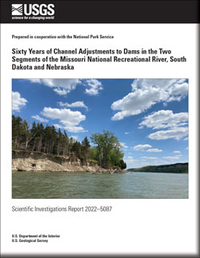Sixty Years of Channel Adjustments to Dams in the Two Segments of the Missouri National Recreational River, South Dakota and Nebraska
Links
- Document: Report (27.0 MB pdf) , HTML , XML
- Data Release: USGS data release - Channel geometry, banklines and floodplain inundation over a range of discharges in two segments of the Missouri National Recreational River, South Dakota and Nebraska, 1955–2018
- Download citation as: RIS | Dublin Core
Abstract
The Missouri National Recreational River (MNRR) consists of two Missouri River segments managed by the National Park Service on the border of South Dakota and Nebraska. Both river segments are unchannelized and maintain much of their pre-dam channel form, but upstream dams have caused reductions in peak flow magnitudes and sediment supply. The 39-mile segment is located between Fort Randall and Gavins Point Dams, transitioning from a riverine process domain to a distributary delta process domain in the headwaters of Lewis and Clark Lake. The 59-mile segment, an entirely riverine process domain, is downstream from Gavins Point Dam, the most downstream main channel dam on the Missouri River, and upstream from a highly altered navigation channel extending more than 1,000 kilometers downstream to St. Louis, Missouri. The National Park Service seeks to preserve the outstandingly remarkable natural, cultural, and recreational values of the MNRR. There is a particular need to understand bank-erosion processes to guide management decisions related to bank-erosion controls.
Changes in channel shape, as measured in topographic cross sections surveyed every 5–10 years since the mid-20th century, document bed incision (bed-elevation lowering) in riverine process domains, a mix of aggradation and incision in the delta, and aggradation in Lewis and Clark Lake. Channel incision is greatest in the 59-mile segment, where mean thalweg (deepest point in a cross section) incision is 3.5 meters, and net incision in the thalweg greater than 5 meters was observed at a cross section 93 kilometers downstream from Gavins Point Dam. Analysis of topographic cross sections also indicates that rates of bed-elevation change since 1960 were lowest in the 39-mile river segment and in Lewis and Clark Lake. Rates of bed-elevation change were higher in the delta and 59-mile segments but lower in cross sections near Gavins Point Dam where the channel is confined by bank revetment on both banks and the bed has coarsened substantially since completion of the dam. Several large floods in recent decades, including a post-dam record flood event in 2011, scoured the bed and deposited large high-elevation sandbars in both river segments, especially in the 59-mile segment. Analysis of topographic cross-sections indicates the 2011 flood event caused substantial erosion and deposition, low magnitude net incision in the river segments and delta, and considerable sediment aggradation in the lake. Surveys taken after the 2011 flood in the 59-mile segment indicate a trend of sediment rearrangement and channel recovery following large floods, with the highest parts of the bed, sandbars, eroding and lowering while sediment was deposited on the deepest parts of the channel, which increased in elevation.
Inundation modeling results indicate that the narrower valley in the 39-mile segment results in a higher percentage of the flood plain being inundated by flooding relative to the 59-mile segment, which has a much wider valley. Likewise, bed incision in the 59-mile segment has increased channel capacity and resulted in a modern channel corridor inset into a higher flood-plain surface. The inset flood plain was inundated by the 2011 flood, but the pre-dam flood plain is rarely inundated. Analysis of channel boundaries over time indicates that pre-dam channel-migration rates were as much as five times larger than modern channel-migration rates in the 59-mile segment. Bank erosion in the 59-mile segment has primarily been into post-1894 channel deposits; bank-erosion rates are comparably very low in the 39-mile segment. Analysis of channel-migration zones indicates that most erosion is isolated to local hot spots and is used to establish predictions for 10 and 20 years into the future based on past movement rates in both MNRR segments. Long-term bed-elevation and planform trends indicate that rates of adjustment in the 59-mile segment are slowing and may be approaching a new equilibrium, but recent large floods and spatial variability contribute to considerable uncertainty. Additional monitoring of channel morphology would be needed to confirm trends observed in this analysis.
Suggested Citation
Elliott, C.M., and Jacobson, R.B., 2022, Sixty years of channel adjustments to dams in the two segments of the Missouri National Recreational River, South Dakota and Nebraska: U.S. Geological Survey Scientific Investigations Report 2022–5087, 75 p., https://doi.org/10.3133/sir20225087.
ISSN: 2328-0328 (online)
Study Area
Table of Contents
- Acknowledgments
- Abstract
- Introduction
- Methods
- Results
- Summary
- References Cited
- Appendix 1. Datasets
| Publication type | Report |
|---|---|
| Publication Subtype | USGS Numbered Series |
| Title | Sixty years of channel adjustments to dams in the two segments of the Missouri National Recreational River, South Dakota and Nebraska |
| Series title | Scientific Investigations Report |
| Series number | 2022-5087 |
| DOI | 10.3133/sir20225087 |
| Publication Date | September 20, 2022 |
| Year Published | 2022 |
| Language | English |
| Publisher | U.S. Geological Survey |
| Publisher location | Reston, VA |
| Contributing office(s) | Columbia Environmental Research Center |
| Description | Report: ix, 75 p.; Data Release |
| Country | United States |
| State | Nebraska, South Dakota |
| Other Geospatial | Missouri National Recreational River |
| Online Only (Y/N) | Y |


